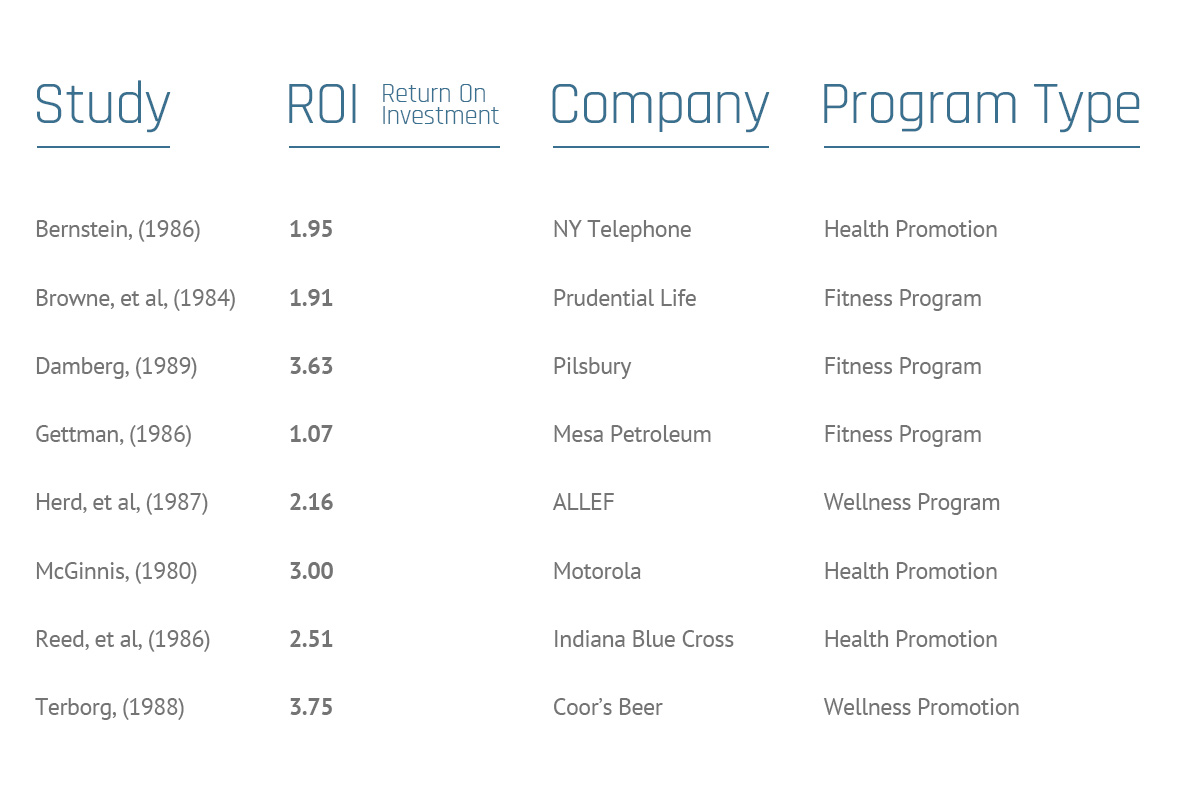Support for Employee Based Wellness and Fitness Programs
Strength Tek
By Lorne Goldenberg BPE, CSCS, CEP
Employee health promotion programs are based on the theory that it costs less to educate workers about controllable lifestyle health risks than to pay for the cost of ill health and disease.
Review of the research reveals current studies that support the following benefits from in-house employee fitness and wellness programs:
- Decreased absenteeism
- Decrease employee turnover
- Reduced health care claims
- Decreased musculoskeletal injuries
- Increased organizational effectiveness
- Return on investment
- Reduced cardiovascular risk
Absenteeism
Absenteeism has been shown to be impacted by employer health promotion programs. The evidence indicates a significant reduction in absenteeism and resultant dollars saved as a result of employee fitness programs.
- Data gathered over a ten-year period at The Canada Life Assurance Company in Toronto, showed that the active decreased their absenteeism by 23.5% over the ten-year period.i
- Evaluation of a comprehensive program at General Mills showed a decrease in absenteeism by 19%.ii
- A 2-year study by the DuPont Corporation on the effect of its comprehensive health promotion program on absence among workers, reported that there was a 14% decline in disability days versus 5.8% in the control group.iii
- A nationwide survey of 8,301 employees showed an inverse relationship between absenteeism and fitness levels. Employees in the lowest fitness categories had 2.5 times the rate of extended sick leave compared to employees in the highest fitness categories.iv
Decreased Employee Turnover
- The Canada Life Assurance Company in Toronto found that employee turnover among program participants has been sustained at an 8% advantage over a seven-year follow-up compared to program dropouts.v
- Tenneco found that those who did not participate in its corporate fitness program were 13% less likely to stay with the company than those employees participating.vi
- Gettman reported a turnover rate twice as high in sedentary employees as compared to physically active employees.vii
Reduced Health Care Claims
There are now a number of studies providing evidence to support the issue of lower medical and insurance costs for participants in health promotion programs, including programs involving physical activity.
- Employee members of the GE Aircraft Engine’s Fitness Centre in Cincinnati had $540,000 less in medical costs when compared to non-members over and eighteen-month period of evaluation.viii
- The Bank of America conducted a health promotion program for $30 per person using a risk assessment, self-care books and other mailed material. With this plan alone, insurance claims were reduced an average of $164 per year in the intervention group, while costs increased $15 for the control group.ix
- Prudential Insurance Company reports that the company’s major medical costs dropped from $574 to $312 for each participant in its wellness program.x
Reduced Cardiovascular Risk
- The Canada Life ten-year follow-up study showed that cardiovascular risk was significantly reduced for those employees participating at a moderate level of activity.i
- An eighteen-month study at the Northern Telecom Bramalea Switching Plant (1988-1990), showed reduced cardiovascular risk among regular participants to their employee fitness program. Cardiovascular risk profiles improved for all employees irrespective of job classification and gender.xi
- About 29 million workdays a year at a cost of $1.5 billion in earnings are lost to American business through cardiovascular disease.xii
Reduced Musculoskeletal Injuries
- A cross-sectional study was conducted on 10,350 full-time regular employees who worked at Shell Oil to investigate personal and job-related characteristics of musculoskeletal injuries. Findings from this study suggest that it is possible to reduce the impact of musculoskeletal injuries through implementation of an integrated injury prevention program which includes medical counselling and support for personal fitness programs.xiii
- Of all the Workers’ Compensation Claims filed in the Province of Ontario in 1992, more than 50% were related to musculoskeletal injuries (sprains and strains). Of all the musculoskeletal injuries documented, 34% were due to back pain.xiv
Increased Organizational Effectiveness
- At the Canada Life Assurance Company, regular participants in the on-site fitness program scored significantly higher than the inactive groups in their attitudes towards co-workers, supervisors and work.i
- Holzbach and others reported in the Journal of Occupational Medicine, a two-year study in which seven companies were studied; four with comprehensive health promotion programs and three without. The four companies with programs had significantly more positive changes related to organizational commitment, supervision, working conditions, pay and fringe benefits and job security.xv
Return on Investment
- Dupont in the U.S. reports that by the second year of their on-site fitness and wellness program a $2.05 return was realized for every dollar invested. In terms of reduction in absenteeism, an absolute dollar savings figure of $1,596,877 was calculated.iii
- A U.S. study of Johnson and Johnson’s on-site wellness program shows a savings of $378 per employee due to decreased absenteeism and medical benefit costs.xvi
- The Canada Life Assurance Company’s Fitness and Lifestyle Program calculated a return of $6.85 on each dollar invested. The main benefit items were reduced employee turnover, greater productivity and reduced medical insurance claims.v
Return on Investment Ratios Estimated For Corporate Fitness/Wellness/Health Programs

Adapted From Shephard, 1992, Medicine and Science in Sports and Exercise
References
- Walker, et al, 1989
- Wood, et al, 1989
- Bertera, 1990
- Tucker, et al, 1990
- Shephard, 1992
- Tsai, et al, 1989
- Gettman, L.R., 1986
- Hollenback, et al, 1991
- Fries, J, et al. Two-year results of a randomized controlled trial of a health promotion program in a retiree population. American Journal of Medicine May 1993: 455-462.
- Thompson, D. Wellness works for small employers, too. Personnel, March 1990: 26-28
- Salmon, et al, 1992
- NIH, 1990
- Tsai, 1992
- Workers’ Compensation Board of Ontario Annual Report, 1992
- Holzbach, 1990
- Jones, et al, 1990




